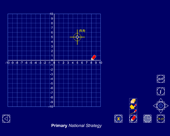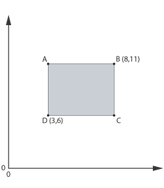Consolidation and practice
These resources are to support children in guided or independent work. Roll over the highlighted resource for a description.
Coordinates

This interactive teaching program (ITP) is an ICT-based tool to support the exploration of coordinates. Coordinates ITP allows the child or teacher to use a marker to identify the coordinates of points on different grids, mark points and draw lines and shapes, working in one, two or four quadrants to introduce both positive and negative coordinates. The ITP can also be used to explore the properties of 2-D shapes and to predict translations, rotations and reflections of various shapes in the different quadrants.
Opportunities to use and apply
Possible contexts include:
- finding all possibilities, e.g. If (6, 5) and (8, 5) are two vertices of a square, how many possibilities are there for the pair of missing vertices? What are they?
- geography, e.g. Identifying and recording references for where children live, and other features of their locality, on a map.
- reflection and translation, e.g. Sketch the reflection or translation of a shape and record its new coordinates. Use this to predict the coordinates of the shape if it were reflected or translated again.
Confirming learning
Ask probing questions such as:
- Here is a shaded square.

Write the coordinates for point A and point C. Explain how you worked them out. Did you annotate the diagram? How did his help? If you reflected the square along the side BC what would the new coordinates of the vertices of the square be?
- Three of the four vertices of a square are (3, 10), (5, 12) and (7, 10). Work out the coordinates of the fourth vertex.
- What could the coordinates be for a square with sides that are not parallel or perpendicular to the axes?
 Understanding shape
Understanding shape

